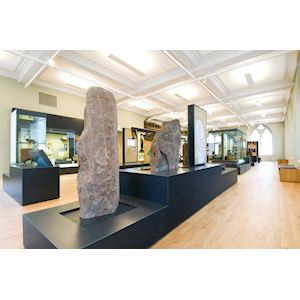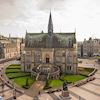
09. PICTS IN LANDSCAPE AND LIVES 2
The Picti or ‘Painted People’ were the indigenous inhabitants of Scotland, living north of the Forth and Clyde estuaries. Few of their writings survive, and descriptions of the Picts are based on accounts by others. This lack of definitive evidence – along with the Pict’s use of enigmatic symbols on stone and metal, gives these people a mystery that inspires myth. Stones, like the ones you see here, are the most identifiable objects associated with Pictish culture. Large stones were erected throughout the landscape. Pictish symbols like the ones on these stones appear together with Christian motifs and secular scenes of battle and hunting. These images give us an idea of how privileged Picts dressed, and of the possessions they wanted to display. The Picts were farmers, horse breeders and craftsmen, but they most commonly depict themselves as warriors. The name ‘Picts’ disappears from the historical record in the 9th century AD. Though their name changed, the Picts themselves did not disappear; they are, in fact, the ancestors of people living in Scotland today. Now take a look at the standing stone on the right hand side of the plinth. This is called the Aberlemno Pictish stone number 4. Can you see the scratch marks running over the design? This is a clue as to how the stone was discovered. In 1962 a young man named William (Wull) Thomson was working in a field at Flemington Farm, near Aberlemno, when his plough hit something – Wull had discovered a Pictish carved stone, and those scratch marks are from his plough. You can see that the stone has two symbols carved on an unshaped block of Old Red Sandstone. This is the earliest type of Pictish symbol stone. New research has pushed back the date of these stones to 3rd – 4th century AD, much earlier than originally thought. There’s a growing consensus that the symbols represent a type of language. When you’re ready to move on, please walk to the large flag on the left, near the exit of the gallery.


The McManus: Dundee's Art Gallery and Museum
The McManus: Dundee’s Art Gallery and Museum is situated in the centre of Dundee. The Museum and Art Gallery originally known as the Albert Institute was opened in 1867 as a memorial to Prince Albert. In 2005 The McManus closed for a major refurbishment, reopening again on the 28th February 2010. We celebrated our 150th Anniversay in 2017 with a year of celebration. In 2020 we were awarded Visitor Attraction of the Year by Visit Scotland. The McManus has 8 galleries, which are laid out on 2 floors. Visitors can embark on a journey through 400 million years, and witness how a small settlement developed into the City of Dundee as it is today. From exhibits relating to the life of early man in the area, stunning paintings and decorative art through to artefacts from industries past and present, the City's collections, many of which are recognised as being of national significance, give an insight into Dundee and its people.
- The McManus: Dundee's Art Gallery and Museum
- Dundee United Kingdom
- www.mcmanus.co.uk
